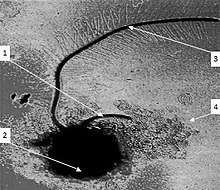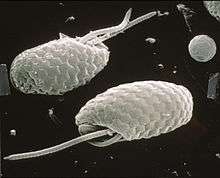Mastigoneme

Schematic drawing of Cafeteria roenbergensis (Heterokonta: Bicosoecida) with two unequal (heterokont) flagella: an anterior straminipilous (with tubular tripartite mastigonemes) and a posterior smooth

A chrysomonad (Heterokonta: Chrysophyceae) under TEM, with a smooth flagellum (1) and another covered with mastigonemes (3)

Two crysomonads (Chrysophyceae) under SEM, with less conspicuous mastigonemes
Mastigonemes are lateral "hairs" found covering the flagella of heterokont and cryptophyte algae.[1] They are approximately 15 nm in diameter, and usually consist of a tubular shaft that itself terminates in smaller "hairs". It is believed that they assist in locomotion by increasing the surface area of a flagellum.
Typology of flagella with hairs:[2][3][4][5][6]
- whiplash flagella (= smooth, acronematic flagella): without hairs, e.g., in Opisthokonta
- hairy flagella (= tinsel, flimmer, pleuronematic flagella): with hairs (= mastigonemes sensu lato), divided in:
- with fine hairs (= non tubular, or simple hairs): occurs in Euglenophyceae, Dinoflagellata, some Haptophyceae (Pavlovales)
- with stiff hairs (= tubular hairs, retronemes, mastigonemes sensu stricto), divided in:
- bipartite hairs: with two regions. Occurs in Cryptophyceae, Prasinophyceae, and some Heterokonta
- tripartite (= straminipilous) hairs: with three regions (a base, a tubular shaft, and one or more terminal hairs). Occurs in most Heterokonta
References
- ↑ Hoek, C. van den, Mann, D. G. and Jahns, H. M. (1995). Algae : An introduction to phycology, Cambridge University Press, UK.
- ↑ Webster & Weber (2007).
- ↑ South, G.R. & Whittick, A. (1987). Introduction to Phycology. Blackwell Scientific Publications, Oxford. p. 65, .
- ↑ Barsanti, Laura; Gualtieri, Paolo (2006). Algae: anatomy, biochemistry, and biotechnology. Florida, USA: CRC Press. pp. 60-63,
- ↑ Dodge, J.D. (1973). The Fine Structure of Algal Cells. Academic Press, London. pp. 57-79,
- ↑ Lee, R. E. (2008). Phycology (4th ed.). Cambridge University Press. p. 7, .
This article is issued from
Wikipedia.
The text is licensed under Creative Commons - Attribution - Sharealike.
Additional terms may apply for the media files.